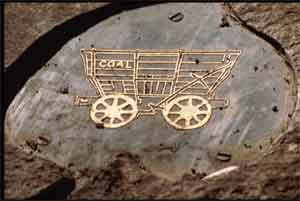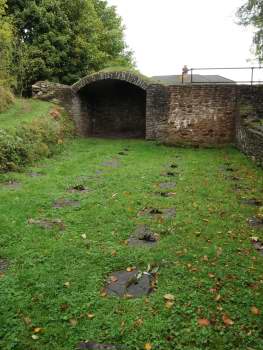 |
|
     |
|
Other Past ProjectsThis section covers other projects the AIBT has been associated with. They include the Dramway, the Nailsea Glassworks, and the Ram Hill Colliery in the 1980s and 1990s, and the Lower Fields Windmill, Pucklechurch, William Smith's Quarry, Combe Down, the Bristol photographic exhibition 'Brunel Through the Lens', and the Middle Pit Powder House, Radstock in the 2000s and 2010s. Lower Fields Windmill - PucklechurchIn 2008 the AIBT helped finance the repair of a c.1910-vintage metal windmill that had once supplied water to a farm in the Pucklechurch district of South Gloucester. William Smith's Quarry - Combe DownIn 2008 the AIBT provided some of the funds for an archaeological exploration at the site of William Smith�s quarry in Combe Down, Bath and North East Somerset. The work was looking for the remains of the tramway. Brunel Through the LensIn 2006, the 200th anniversary of the birth of the engineer Isambard Kingdom Brunel was marked in Bristol with a series of events under the banner Brunel 200. His projects in the city include the Clifton Suspension Bridge, the SS Great Britain, the original train shed at Temple Meads, and he was also involved with work on parts of the floating harbour. The AIBT felt that these events would provide an opportunity to publicise the area�s industrial heritage, and collaborated with the North West Bristol Camera Club (NWBCC) on an exhibition of photographs of Brunel�s work in the region. The main exhibition was held in the Council House during May 2006, and among the subsidiary events were two tours, one to the Cumberland Basin and Floating Harbour, and the other to Hanham Lock. These were guided by both AIBT and NWBCC members, who combined to give the participants information on both Brunel�s work and on the photographic opportunities. Over 1 000 images were taken and submitted for viewing. Further information on the North West Bristol Camera Club is available on their website. Middle Pit Powder House - Norton RadstockIn 2003 the AIBT was asked to assist with raising finance for the restoration of the former Powder House at the Middle Pit Colliery in Norton Radstock, Bath and North East Somerset. The colliery had started operations in 1780 and closed in June 1933. The powder house was used for storing the explosives used underground. The powder house had been purchased for restoration by a local enthusiast, and Radstock Parish Council and English Heritage provided the funds. The work was done by a local builder, and completed on time and under budget. Further information on the history of the colliery may be found in the History of the Somerset Coalfield by G C Down and A J Warrington (David and Charles, 1971, ISBN 071535406X, p.167-171). The DramwayThe Dramway was a horse drawn railway that ran from the Ram Hill Colliery to Mangotsfield, where it branched. One line, opened in 1831, ran to the River Avon near Keynsham, while the other, which was opened four years later, ran to the Floating Harbour in Bristol. The latter was converted to locomotive power after 9 years, and was bought by the Midland Railway in 1845. The route to Keynsham was bought by the Great Western Railway in 1851, but remained horse drawn. As a result separate lines had to be laid for the section around Mangotsfield where the two methods of haulage overlapped. The route took it past the site of the Brandy Bottom Colliery.
Many sections of the route line the Dramway took are now accessible to the public as foot and cycle paths, and it is possible to see the remains of limestone sleepers on a stretch near Warmley. There are also examples of the rails and sleepers at the Kingswood Heritage Museum in Warmley. Little else has survived, though there are the remains of loadings bays at the Ram Hill Colliery. Photo right: Plaque along the route of the Dramway by M Adams Further InformationThe Dramway, Ross Barber, Avon Industrial Buildings Trust, 1986. (ISBN 0951152300) Nailsea GlassworksNGR: ST. 477708 A Brief HistoryJohn Robert Lucas established the Nailsea glassworks in 1788 to produce crown glass for windows and bottles. The raw materials for glassmaking, especially coal, were available from local sources, but the site was isolated and the company had to provide housing for the workforce. The glassworks closed in 1873 when the Nailsea mines no longer produced coal suitable for glassmaking. The works became derelict, and attempts were made to sell the land for development in 1889 and 1905. The furnace cones were only demolished in the 20th century and the site was built over in stages. In his 2004 report, Smith places the Nailsea glassworks in its heyday as one of four major glassworks in the country. The site was awarded a 3* rating, indicating �major national or international importance� in the March 1966 report of the English Heritage Monuments Protection Programme (The Glass Industry). RestorationThe 5.5 hectare site lies partly exposed alongside the High Street, but the major part lies beneath a TESCO Supermarket and 20th century housing, approximately N and E within the 1788-1873 complex. Authorised archaeological interventions off the High Street started in 1983 and continued until 1988, with the AIBT providing supervision from 1984/5 onwards under T Downey and B Bentham. Various re-development proposals have been put forward over the years by Hobbs Properties, co-owners of the High Street portion of the site, but have not materialised. Further trial excavations took place during this period, associated with actual and proposed re-development, including those by the Avon Archaeological Unit in early 1995. Approximately 20% of the original site was scheduled in 2004 and includes the supermarket car park, the 1826/7 �New House� Cone foundations and the �Glasshouse Pit� engine house, horse whim and shaft collar. The upper stonework of the latter engine house had been stabilised by the AIBT in the mid-1980s and an iron gate fitted for security. Further InformationThe Nailsea Glassworks, Nailsea, North Somerset: A Study of the History, Archaeology, Technology and the Human Story, Andrew F Smith, Avon Archaeology Unit The Nailsea Glassworks, Margaret Thomas, published by HG & MA Thomas, 1987 Industrial Archaeology of the Bristol Region, Robert A Buchanan and Neil Cossons, David and Charles, 1969, p.147
There is more information on glassmaking in the Nailsea area on the website of the Nailsea and District Local History Society. Ram Hill CollieryThe Ram Hill Colliery, near Coalpit Heath, was one of the main local collieries supplying coal to Bristol at the height of the Industrial Revolution between 1830 and 1860. It is located at the head of the Dramway, which took the coal to Bristol and Bath. There are no complete buildings left at the site, but remains of the Dramway loading bays, the mineshaft, a horse gin and the engine house are visible. It is possible that traces of a stone-lined reservoir and of the boiler house exist. Photo right: End of the Dramway at Ramhill by R Whitworth, October 2017 The AIBT took part in preliminary excavations at Ram Hill in the 1980s. The Ram Hill site is owned by South Gloucestershire Council, and further information on its history and archaeology is available on the council website. A group of volunteers �Friends of Ram Hill Colliery� was formed in summer 2004 to oversee the colliery�s preservation. The friends' website has full details about the site and its history, as well as information about the group and their work schedules. Page updated 15 Oct 18 |
|
| [email protected] | |

